Summer, Cicadas, and the Girl is a freeware doujin (think “indie”) visual novel from Japan that was first published there on June 19, 2005. The short story was officially translated into English and submitted to the 2006 al|together visual novel translation festival. I am working toward reviewing nearly all of the visual and sound novel translations that were submitted to the 2005, 2006, and 2008 al|together festivals. Summer, Cicadas, and the Girl is my eighth review of the project.
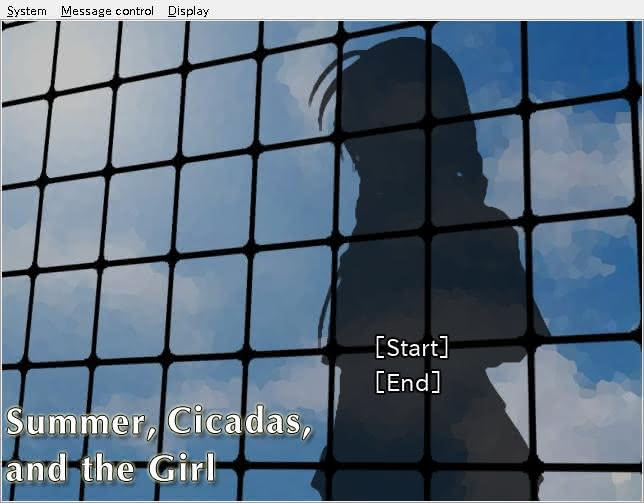
You can learn more about my al|together project by reading my project introduction article. That article includes a running list of our completed al|together reviews. I have a dedicated collection post with links to all of our al|together articles, including reviews, essays, and short posts.
Summer, Cicadas, and the Girl is a very short visual novel where the player is presented with a small mystery. The visual novel introduces an interesting mechanic for inputting an answer to said mystery and proceeding to the story’s true ending if the answer is correct or to one of the variations of the ending when the player fails to solve the mystery. Summer, Cicadas, and the Girl is one of the more creative al|together entries thanks to its mechanic. Below, I will review the visual novel in all of its respects – omitting spoilers.
(Updates for June 8, 2023: I made some formatting, name, and URL changes to make the style of this review consistent with my other al|together reviews.)
(Non-)Spoiler Note
I will discuss the structure of Summer, Cicadas, and the Girl and provide an overview of the story. However, I will not include any content that points to the answer to the mystery that the player is presented with toward the end of the game. Thus, you may consider the instant review spoiler-free. However, if you are already interested in playing Summer, Cicadas, and the Girl, I recommend doing so before reading my review. The main story only takes a few minutes to read from beginning to end. I include a link to a guide to Summer, Cicadas, and the Girl in the final section of this review, prefaced by numerous warnings about opening the link.
Summer, Cicadas, and the Girl Details
English Translation Details
| Name | Summer, Cicadas, and the Girl |
| Translator | Shii |
| Release Date | 2006 |
| Engine | KiriKiri |
| Official Website | altogether 2006 |

Original Japanese Game Details
| Name | Natsu, Semi, Shoujo |
| Developer | Kotonoha Meikyuu (JP Website) |
| Original Release | June 19, 2005 |
| Engine | KiriKiri |
| Official Website | Link. |
Windows Icon

Downloading and Running Summer, Cicadas, and the Girl
Summer, Cicadas, and the Girl remains free to download for Windows from its official English website. The http link works for those who are unable to use the torrent link, but the torrent should download without too much trouble.
Summer, Cicadas, and the Girl requires a Japanese environment to run, an issue shared by only four other al|together visual novels (e.g., Collage and Until We Meet Again). Although the visual novel is only available as a Windows exe file, I was able to run the game in Linux using a Japanese environment with the help of three graphical front-ends for the Wine compatibility layer (see my article on the steps I used). Windows users (or MacOS users trying to run it on a compatibility layer) should consult guidance specific to their operating systems to figure out how to set up a Japanese environment to read the visual novel. Readers may also need to download Japanese fonts, but I had no font issues with my default set-up on Manjaro Linux when I originally read the novel.
General Overview of Summer, Cicadas, and the Girl
The al|together festival page for Summer, Cicadas, and the Girl includes the following introduction to the short visual novel:
Boy meets girl. Boy wants to meet girl again, and arranges a date. Girl doesn’t show up. Saito’s pretty sure she was interested too, so he’s not going to give up. All he has to do is figure out what happened to her.
Translator’s summary
The description is vague, but fair enough. A young man named Saito is the view-point character for the entire story. While staring at a cicada in a park, he is greeted by a girl he has never met before. We learn that the girl’s name is Kokonoka. Saito and Kokonoka spend the day together, and their small adventure sets the stage for the interactive mystery at the end of the story. Shii, the translator, described the pair as the “combination of a normal guy and a wierdly named, energetic girl.”
Summer, Cicadas, and the Girl Review
Below, I review the different parts of Summer, Cicadas, and the Girl.
Game-Play and Structure
Rather than explain the game-play myself in the first instance, I defer to the game’s readme.txt file, which you will have access to after installing it. The translator, Shii, translated the “How to Play” text written by the game’s original creator, Kotonoha Meikyuu. Unsurprisingly, the creator provided a good explanation of the work. I will re-print the pertinent sections of the readme explanation and append my own commentary.
This is a novel-type adventure. For the most part, you just have to read, though there is one point where you can affect the outcome of the story.
Summer, Cicadas, and the Girl takes about three-to-five minutes (in my estimation) to read once. There are no choices for most of the story, rendering about 90-percent of the visual novel kinetic (meaning no player interaction). At the end of the story, the player is presented with a text box and a mystery. The player must type his or her guess as to the correct answer in the text box. Let us return to the readme:
It’s possible to view the true ending on the first time through, but I imagine it’ll take most people a fair bit of trial and error. (Everything before the interactive point will be the same every time you play…)

Typing the correct answer in the text box takes the player to the “true ending” – which in this case is the best ending to Summer, Cicadas, and the Girl. The true end includes an afterward, which the readme describes as “the goal of the game.” Typing an incorrect answer into the text box will give the player a variation of the non-true ending. I counted seven distinct non-true, or bad endings, that can be obtained depending on the player’s incorrect answer (including a catch-all ending if the player’s input text is not in the visual novel’s dictionary). There are two locations which can only be visited in specific bad endings.
I concur with the creator that it would be unlikely for the reader to find the true end on his or her first guess. The tips in the story proper err on the vague side. However, Summer, Cicadas, and the Girl has a very interesting mechanic to assist the reader in finding the true ending. When the player fails to obtain the true end for the first time, a new field appears on the title screen called “Harbingers: or, a sequel” with a clickable menu item labeled “[1st].” There are five separate harbingers that are unlocked the first five times that the reader reaches an ending other than the true ending (that there are five harbingers most likely corresponds to the fact that there are five specific variations of the non-true ending – not counting the catch-all bad ending for typing something that is not recognized by the visual novel). On the off chance the reader finds the true end before failing five times, all of the harbingers will be unlocked upon completion of the true ending. To the extent the harbingers may help the player, they too are vague, but I will note without specifics that they do reward attentive readers.
A postscript is unlocked after the reader obtains the true ending. The postscript features the creator talking directly to the reader.
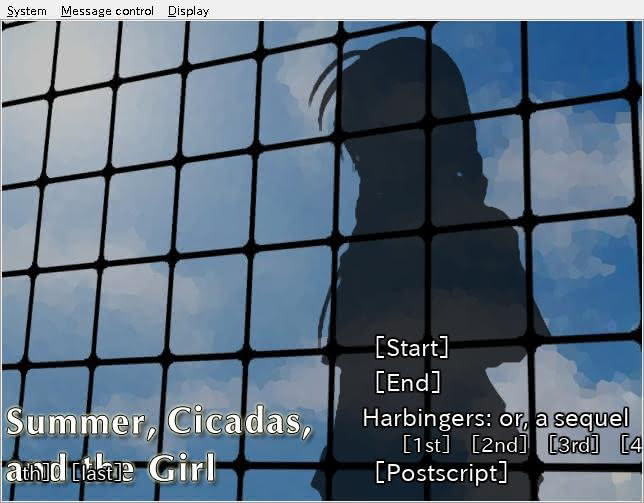
Summer, Cicadas, and the Girl includes a useful skip feature to prevent the reader from having to re-tread ground that he or she already covered. There is a menu above the visual novel. There is an option labeled “Message Control” labeled “Skip through old dialogue” (can also be activated with ctrl + F). This allows the reader to start a new game and skip to the dialogue input point at the end in 2-3 seconds – making it easy to try different answers to the mystery. Another nice feature is that the reader can access the entire text of the visual novel up to the dialogue entry point from the “Message history” option under “Message control” (can be triggered by turning the scroll wheel up or Ctrl + R). The visual novel lacks save functionality, but it is not needed given the short length and overall structure.
Visual Presentation
Like many of the al|together visual novels that we have already looked at, such as From the Bottom of the Heart, Night of the Forget-Me-Nots, Shooting Star Hill, and May Sky, Summer, Cicadas, and the Girl uses real photographs with filters for backgrounds. I counted eight distinct backgrounds between the main story and the five side-stories. The backgrounds are not especially memorable, but they all depict their locations well.

Two locations could have used background images, but the oversight is forgivable.
One visual feature that distinguishes Summer, Cicadas, and the Girl from some of the other visual novels that we have examined is its dialogue box. Each of the previous visual novels using photographic backgrounds that we have looked at thus far did not contain dialogue within a text box. Instead, the dialogue started from the top of the screen and scrolled downward, overlaying the background. However, in Summer, Cicadas, and the Girl, the dialogue is contained to a text box. The text box lists the name of the speaker (provided it is not Saito talking to himself) and the speaker’s portrait is in the bottom-left corner.

The style is reminiscent of what we saw in Instant Death! Panda Samurai – and like that visual novel, there are a few variations on Kokonoka’s character portrait (I counted five) to depict her expression while delivering particular lines of dialogue.

The backgrounds in Summer, Cicadas, and the Girl are hard to distinguish from similar backgrounds in other al|together projects and in some popular commercial visual novels from the first decade of the 2000s (e.g., the Higurashi and Umineko series).

However, the well thought-out text boxes are a nice touch and they add some life to the game’s visual environment.
Music and Sound
I counted six distinct music tracks while reading Summer, Cicadas, and the Girl. In light of the fact that the main story is amenable to reading in three-to-five minutes, the number of music tracks is impressive. None of the songs is particularly memorable – although the mildly haunting title theme is quite nice – but they all serve a purpose in the story. There is a distinct “slice of life” track, a mystery track, and melancholy track. The visual novel also contains two sound effects that stand in lieu of music at two points. The reader is welcomed to the story (after starting) by the sound of cicadas (shocker), and the story also has pitter-patter sound effects for a couple of scenes wherein Saito and Kokonoka are running. There is also one sound effect purportedly signifying a man swinging his umbrella (the weakest of the three effects).
The reader is unlikely to hear any of the tracks in full in a normal reading due to how short the story is, but they all extend a bit before looping if the reader sits on a particular scene.
The only disappointment I had with the music is that the five side-stories (more on those below) do not have any musical accompaniment, although a couple of them do include sound effects.
Translation Quality
I preface my translation review with my standard note that I am only reviewing the English version of Summer, Cicadas, and the Girl, and also that I cannot read Japanese even if I had access to the original visual novel. Thus, my translation review examines how the game reads in English rather than its fidelity to the original Japanese text.
I have come to expect great things from the al|together translations, and Summer, Cicadas, and the Girl did not fall short of my expectations. The translation is high quality throughout, something that is particularly important when the player is ultimately asked to solve a mystery. There was only one example of dialogue early in the game that I found to be a bit awkward – but I am not sure how much of that is the English translation and how much of that is Kokonoka’s colloquialism in the original Japanese. There is one line in the sequence that most likely should have read “summer heat” instead of “heat” without the qualifier (I infer from context).
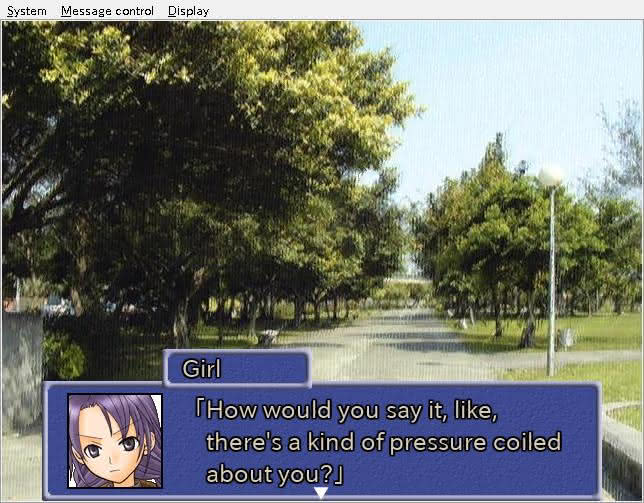
There is one thing that I would have liked to see in the form of a translation note. When Kokonoka and Saito introduce themselves to each other, the dialogue box shows the Japanese characters that make up their names.
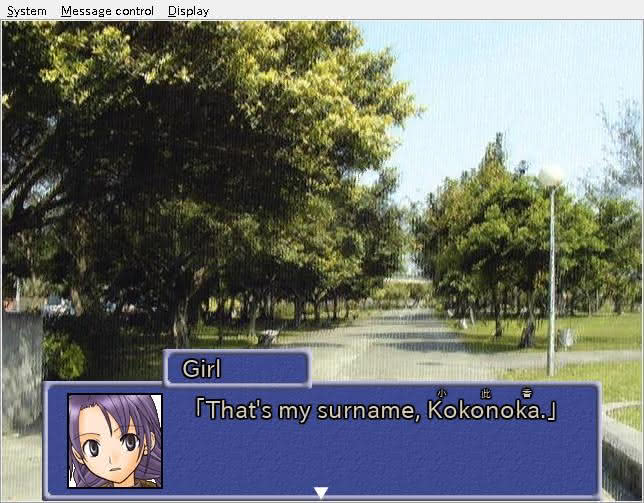
The reason for this is that there is often multiple ways to write a name that otherwise sounds the same in Japanese. It would have been a nice addition to show the English translations for the characters in a parenthetical.
Writing and Story Quality
Taken in isolation, the story of Summer, Cicadas, and the Girl is not particularly memorable, and taking the main story alone and separate from the additional content, it did not have enough time to paint a vivid portrait of Saito and Kotonota and also set up the mystery. Kotonota is a somewhat memorable character on account of her strong personality and unusual phrases.
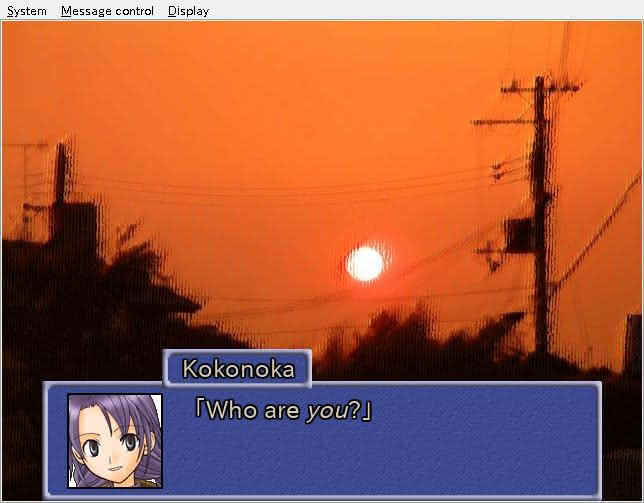
Saito is more or less a neutral stand-in for the player, although some of his personality does come through in a reading all of the novel’s material. The story is ultimately quaint, self-contained, and devoid of loose ends (a stated goal of the author in the postscript).
However, Summer, Cicadas, and the Girl is not a story without player interaction. The visual novel invites the player to study the story and ultimately solve its mystery to reach the true ending.
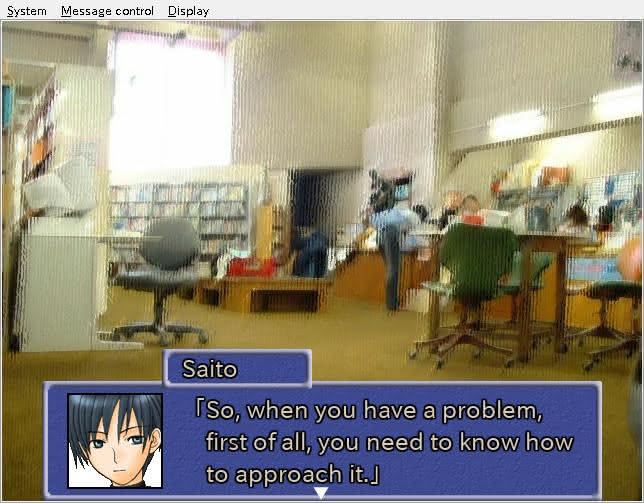
While the true ending, like the story before it, is not notably deep, it does an excellent job of tying all of the disparate parts of the visual novel together, and the sentiments in the ending complement the sense of accomplishment for solving the mystery.
I cannot conclude the instant review without discussing in some way how the story provides clues to the resolution of the mystery of Summer, Cicadas, and the Girl. Because I pledged to make this a spoiler-free review, and also because spoiling the mystery would have the effect of ruining one’s enjoyment of the experience of reading the visual novel, I will tread very carefully in this section. I concur with the author that the mystery is not particularly intuitive, and that most readers will need to attend to all of the harbingers to ultimately resolve it (I needed all five). The story’s major clue did not have the effect of strongly narrowing down the answer to the question of “what happened to Kotonota?” My view on that matter did not change after figuring out the answer to the mystery. Moreover, I think that it may be the case (from my vantage point) that the clue may have been more intuitive when the story was originally released in 2005 than it is today.
Final Thoughts
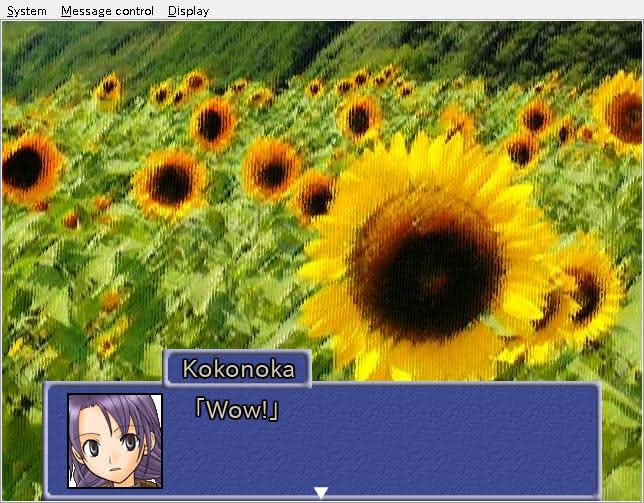
Absent its mystery mechanic, Summer, Cicadas, and the Girl would have been a nice short al|together entry, but an ultimately forgettable one. However, its implementation of its mystery mechanic was genuinely creative, and I enjoyed trying different answers and studying the harbingers to ultimately reach the true ending. While the story itself is nothing remarkable, the catharsis of the true ending complements the reader’s sense of accomplishment. The author also showed great attention to detail in the work. In particular, I appreciated the structure and implementation of the harbingers, the number of variations of the non-true ending, and how the true ending ties the whole package together. None of this would have been enjoyable for English readers without Shii’s excellent translation.
Summer, Cicadas, and the Girl is a genuinely fun work. It is not without its shortcomings, but it comes with my full recommendation for all New Leaf Journal readers. The experience is interesting enough to warrant the minor annoyance that comes with setting up a Japanese language environment for the purpose of running the visual novel.
Link to Endings Guide
I played through Summer, Cicadas, and the Girl numerous times to try to discover all of the story’s endings and the words recognized by its input dictionary. If you are playing and stuck, you can use my guide in lieu of giving up. If you completed the true end but want to make sure that you did not miss anything, my guide is for you. Do note that I do not at all recommend reading the guide if you plan to play Summer, Cicadas, and the Girl or if you are reading it but have not done your utmost to discover the true end.
With those warnings noted, you can read my guide here: Official NLJ Endings Guide for Summer, Cicadas, and the Girl.